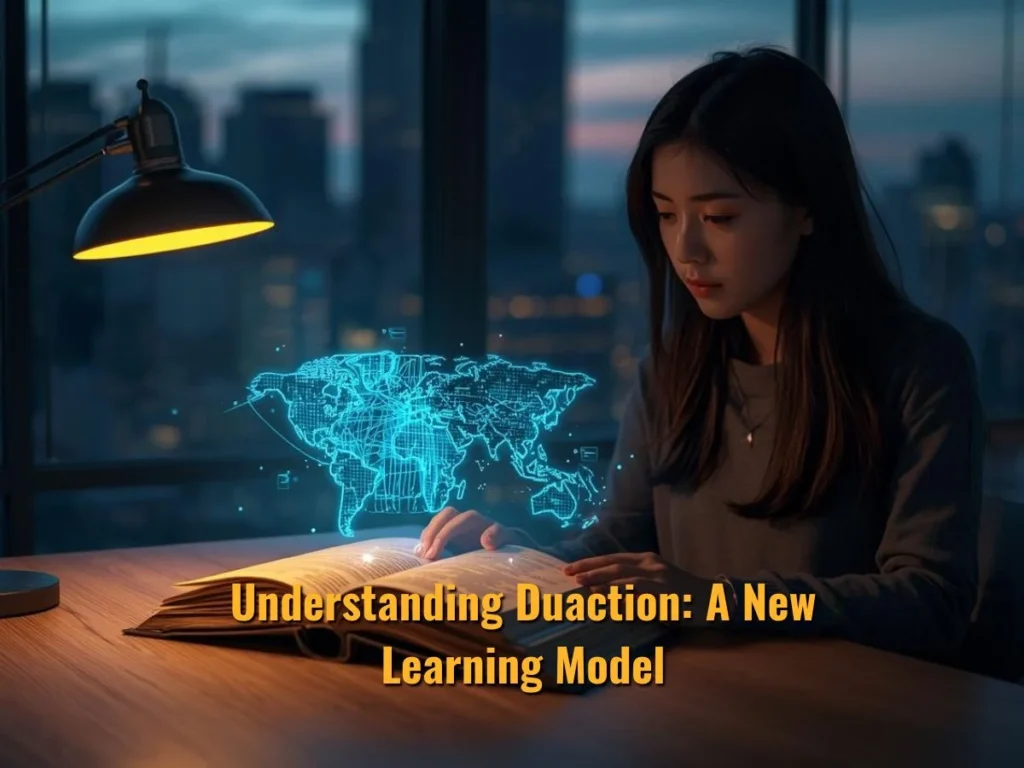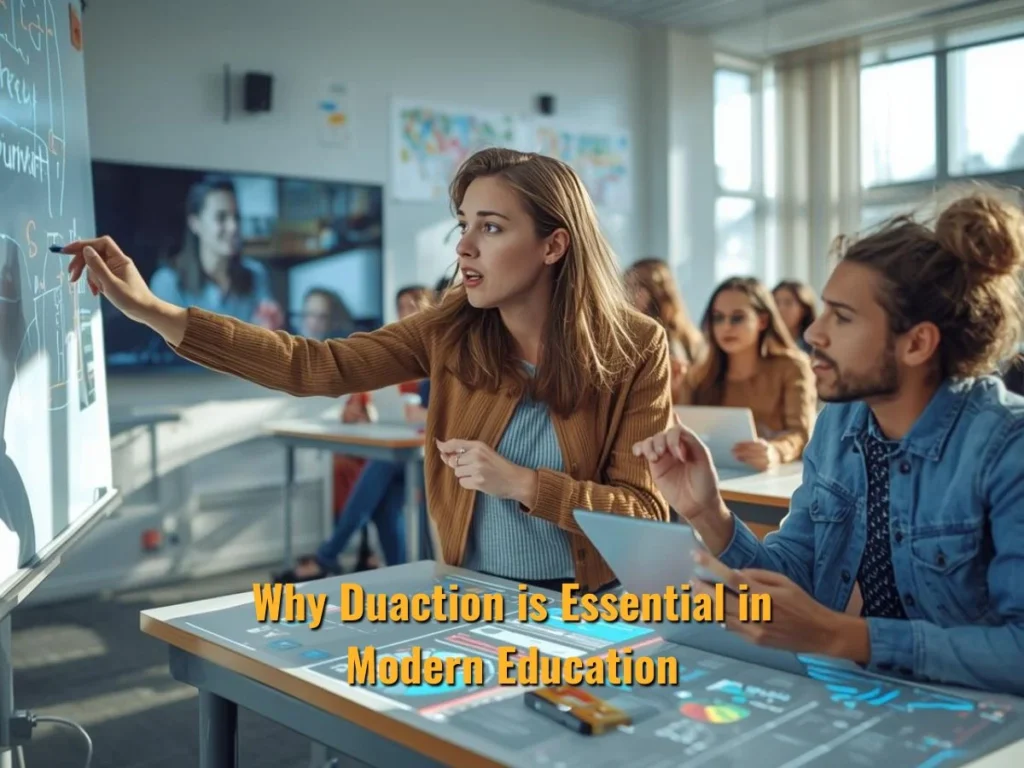Intoruction
Education is a rapidly changing field, and Duaction demonstrates this change quite dramatically.
Traditional classrooms often prioritize memorization and testing, which can cause learners to disengage from the learning process and struggle to apply knowledge in meaningful ways.
Contemporary education requires more than rote memorization; it calls for techniques to cultivate curiosity, critical thinking, and application to real-life issues.
By integrating theory with practical application right away, students and practitioners understand that they can apply these lessons to “what they do on Monday.”
The result is a learning experience that not only raises retention but also increases confidence, flexibility, and skills that last well beyond the classroom.
Understanding Duaction: A New Learning Model

Duaction is a romance word for “dual action,” the synergy between theory and action.
Rather than enduring passive listening, participants put the lessons into practice by dealing with real scenarios, engaging in role-playing, and participating in problem-solving activities.
- And science students conduct experiments instead of just reading about them.
- Workers strengthen leadership skills through simulations.
- You learn as professionals work on live projects.
This balance not only makes learning more interesting but also more meaningful and enduring.
How Duaction Differs from Traditional Methods
Traditional instruction often separates theory and practice. Students sit through lectures, write notes, and later regurgitate that knowledge in exams. However, the moment it is no longer in use, this knowledge slips away.
Duaction transforms that process. Learners use information in the way they are learning it, which helps lessons stick. It encourages, as an alternative to traditional education:
- Active involvement as opposed to passive note-taking
- Real-world results, not theoretical examples
- More retention through instant application
This two-handed approach to tackling the game is a way to blend what’s learned in the classroom with what’s learned on the court.
Practical Applications of Duaction
This model is capable of learning from others and adapting independently, which is one of its key strengths. It does well across every school, workplace, and university.
- Schools: Collaborative projects, debates, and labs link lessons to real-world effects.
- Corporate employee training: Role-plays orient employees toward the real challenges they will face.
- Universities: instead of studying the theory, students solve live business case studies.
- Vocational programs: The students practice with simulations and actual machinery.
Benefits for Learners and Educators
The significance of Duaction also reaches out to students and teachers.
For learners:
- Enhanced critical thinking and flexibility
- Stronger problem-solving skills
- It’s got a lifespan beyond the study period
For educators:
- Higher classroom engagement
- Better measuring of the skill used
- Better overall outcomes
Active and project-based learning research continues to show increased retention and satisfaction when compared to lecture alone, adding weight to why the dual model has stood the test of time.
How to Implement Step by Step
Teachers looking to adopt this approach can take a straightforward route:
- Establish learning targets: Determine the skills or knowledge outcomes that are most important to you.
- Combine teaching and doing: Teach theory, followed immediately by practical activity.
- Select concrete examples: Present case studies and real-life situations that everyone can relate to.
- Add reflection: Allow learners time to assess what worked and what didn’t.
- Track results: Judge not only the theory but also the applied understanding.
Even baby steps toward hands-on can make a difference.
Duaction vs. Other Active Learning Models
This model is often contrasted with project-based or experiential learning. It’s different enough to offer unique advantages:
- Experiential learning emphasizes doing, sometimes at the expense of sufficient theory.
- Project-based learning involves long-term group projects.
- Duaction is a theory that also has an immediate practice, making it easy to use.
Its versatility has enabled its application in various areas, ranging from science to business training.
Case Study: Duaction in Higher Education
An institution of higher education experimented with it in the business school.
Rather than sitting through standard lectures, students helped local companies with real challenges. They researched, suggested fixes, and reported back to executives with their findings.
The outcomes were striking:
- More participation in discussions in class
- Better decision-making and critical thinking
- Stronger preparation for internships and jobs
This is an example of how the method powerfully connects academic and industry research.
Challenges and Limitations
Duaction is a strategy for improving education like any other, and it is not without its obstacles:
- Teachers require more time to prepare.
- Some students rebel against active methods after years of lecture-based schooling.
- Larger classrooms may be challenging to facilitate interactive techniques within.
- Standardized testing often doesn’t accurately assess applied knowledge.
Recognizing these obstacles helps institutions adapt their strategy and develop successful combinations of old and new.
The Future of Duaction in Modern Learning
This model has unlimited possibilities as technology continues to evolve. Imagine:
- AI simulations to simulate decision scenarios
- Virtual reality labs for medical or engineering students
- Digital collaboration tools for smooth teamwork
With this tool, Duaction can be extended to larger groups of students, offering a more interactive learning experience.
Why Duaction is Essential in Modern Education

As an effective pedagogical approach, active learning has positioned students as key players in their own learning. Rather than simply receiving, students are asked to participate, question, and actively work with the creations they see on the screen.
This approach fosters critical thinking, creativity, and collaboration skills that are essential in school and beyond.
Group exercises, role-plays, and project work, for example, give participants the opportunity to try things out, make mistakes, and learn through experience – in ways that don’t have consequences.
There is ample evidence that people who learn actively remember more and maintain a higher level of interest in continuing to explore new ideas.
Moreover, active learning also serves as a connecting link between theoretical inputs and practical application, making learning more pragmatic and effective.
As industry and workplaces demand adaptability and the ability to solve complex problems, active learning ensures that our students are ready to succeed in the world of tomorrow.
Conclusion
In today’s rapidly evolving world, rote memorization doesn’t cut it for learners in preparing for success.
What they need are flexibility, confidence, and a talent for thinking outside the box. Duaction answers the call, bridging the gap between the two.
It’s not about theory for the sake of theory; it’s about theory and practice so that your knowledge serves you, instead of sitting unused in your head somewhere.
For students, this method has a longer-lasting understanding and makes students even more prepared for real-world problems.
For teachers, it promotes more active engagement, more sustained participation, and more demonstrable progress than traditional testing alone.
Through active learning and relevant application, this model not only provides the possibility for better education, where skills are gained, polished, and carried on with in all life stages.
FAQs
How is this approach different from traditional teaching?
Its emphasis is on the application of knowledge rather than simply memorizing it.
What is the use of Theory and Practice Mixed?
It facilitates better retention by transforming ideas into practical skills.
Can it have an application in workplace training?
And yes, it’s a perfect match for hands-on professional learning.
What skills do learners gain?
They foster problem-solving, adaptability, and critical thinking.
Is it applicable to students and professionals?
Yes, for optimal learning at all levels.




